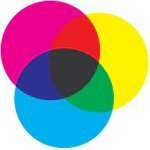Thank you for visiting the HONG KONG HP Store
-
Contact Us
CONTACT USChat with us
- Our specialist are here to help
- Live chat
- Sales
- 85264507529(WhatsApp)
-

- Post Sales
- 85230016720(WhatsApp)
Mon-Fri 8.30am - 5.30pm
(exc. Public Holidays)
Live product demo
Store finder Locate our storesSubmit feedback We value your opinion! - Location
- My Account
Search
Print Basics: RGB Versus CMYK

Posted:
January 09, 2023
Categories:
Monitor

The colours on your website don’t quite match your business cards. Your latest flyers are clashing with your trade booth banners. And your promotional video is looking decidedly washed out on your client’s monitor.
The key to understanding colour is to realize that all the different shades that we can recognize, from vermillion to periwinkle, are actually mixed from just a few primary colours. For example, red plus yellow creates orange, while yellow plus blue creates green. So by defining that mixture, we can define precise colours. RGB and CMYK are really just descriptions of how to mix colours. RGB stands for Red, Green, and Blue, while CMYK stands for Cyan, Magenta, Yellow, and a Key colour (most often black).
As for why there’s more than one standard, the process for mixing colours fundamentally differs between printing and monitors. First, let's tackle printing.

CMYK colour is “subtractive”.

RGB colour is “additive”.
Get exceptional, consistent colour precision from your PC display.
[1] Proceedings of the SIGCHI Conference on Human Factors in Computing Systems, Trust and mistrust of online health sites
[2] Behaviour & Information Technology, Attention web designers: You have 50 milliseconds to make a good first impression!
Adobe and Photoshop are either registered trademarks or trademarks of Adobe Systems Incorporated in the United States and/or other countries.
What happened?
First impressions are 94% design related [1], so a little colour knowledge can make a big difference to your bottom line. Take our crash course on what every business needs to know about colour from your printer to your monitor and how you can make sure every brochure and browser shows your business at its very best.RGB, CMYK, ETC?
If you’ve ever replaced a colour toner cartridge or adjusted your display properties, you’ve probably noticed different abbreviations for how to describe colours. RGB and CMYK are the most frequently cited, but there are dozens of others. It can feel pretty technical. After all, red is red, right? So why do we need different ways of describing them? And why do those colours end up looking different on our monitors, printers, and smartphones?The key to understanding colour is to realize that all the different shades that we can recognize, from vermillion to periwinkle, are actually mixed from just a few primary colours. For example, red plus yellow creates orange, while yellow plus blue creates green. So by defining that mixture, we can define precise colours. RGB and CMYK are really just descriptions of how to mix colours. RGB stands for Red, Green, and Blue, while CMYK stands for Cyan, Magenta, Yellow, and a Key colour (most often black).
As for why there’s more than one standard, the process for mixing colours fundamentally differs between printing and monitors. First, let's tackle printing.
PRINTING colour
Printed material absorbs light. Just like when mixing paints, if you mix all of your colours together you’re putting more ink on the page. That ink absorbs more and more different spectrums of light until you ultimately get black. You can think of printed colours as “subtractive.” That is, as you add colours (or ink), it visually reduces the colour reflected off the page, and leaves you with a muddy brown or black when they’re all mixed together, as seen in the image below:
CMYK colour is “subtractive”.
PROJECTING colour
In contrast to printing, monitors and other electronic screens are light sources. Instead of absorbing some spectrums of light and reflecting others, computer monitors and TVs actively project light towards the viewer. You can think of projected colours as “additive.” As you add more and more colours on a monitor, you add more light, creating brighter colours. Add enough colours, and you get white, rather than black, as seen in the image below:
RGB colour is “additive”.
What colour means for your business
Here are some tips for putting your new colour knowledge to practice in your business:- If people are going to see it on a computer monitor, choose RGB. If you’re printing it, use CMYK. When using an image-editing program, you should know whether you’re using RGB vs CMYK. Deciding which to use, however, depends on what your output will be. (Tip: In Adobe® Photoshop®, you can choose between RGB and CMYK colour channels by going to the Image menu and selecting Mode.
- If you’re developing a new brand or campaign, make sure your designer is choosing colours that can easily be produced across all mediums. This will ensure your business is consistently represented in both print and electronic mediums. Otherwise, you may be disappointed by the results - and printing mistakes can be a lot more costly to fix than changing colours on a website.
- Finally, to get a better sense of how a final product will look before you print it you need to properly calibrate your monitor. This is because ambient light can affect how you see the colours on the screen. The best monitors, like HP Dreamcolour displays, feature support for professional instruments to make sure what you see is what you get when you print.
- Quality ink and toner also matter in terms of print quality for reproducing what you see on the screen accurately in real life.
Snap judgments
It takes about 50 milliseconds (that’s 0.05 seconds) [2] for users to form an opinion about your website - a snap judgment that determines whether they like your site enough to use it or not. Keep your business looking great across all mediums by harnessing the right colour mode for each situation and providing your customers with a seamless visual experience.Get exceptional, consistent colour precision from your PC display.
[1] Proceedings of the SIGCHI Conference on Human Factors in Computing Systems, Trust and mistrust of online health sites
[2] Behaviour & Information Technology, Attention web designers: You have 50 milliseconds to make a good first impression!
Adobe and Photoshop are either registered trademarks or trademarks of Adobe Systems Incorporated in the United States and/or other countries.
CONTACT US
Chat with us
- Our specialist are here to help
- Live chat
- Sales
- 85264507529(WhatsApp)
-

- Post Sales
- 85230016720(WhatsApp)
Mon-Fri 8.30am - 5.30pm
(exc. Public Holidays)
Live product demo
Store finder
Locate our stores
Submit feedback
We value your opinion!









